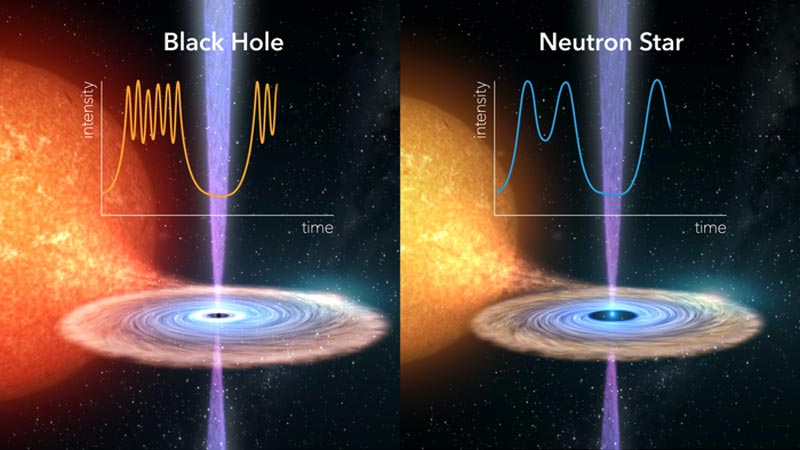

Artist's impression of the blazing eruption of the neutron star Swift J1858 compared to the black hole GRS 1915+105
Credit: Gabriel Pérez Díaz (IAC)
… only observed in black holes.
X-ray binaries are systems formed by a compact object, a neutron star or a black hole, and a star of a similar size to the Sun. The compact object swallows matter from the companion star through a disk that emits large amounts of light, especially in X-rays. This process in which the compact object attracts matter, known as accretion, usually occurs in violent eruptions during which the system becomes up to a thousand times brighter. In addition, part of the removed material that spirals down towards the compact object in the disk is ejected back into space through winds or in the form of jets of matter.
The X-ray binary known as Swift J1858.6-0814 was discovered in 2018 during one of these spectacular eruptive episodes, baffling the astronomical community since the earliest observations. The system showed incredible flares for a year, emitting at all wavelengths from radio waves to X-rays. The origin of these “cosmic fireworks” was unknown, but they were so bright that the scientific community believed that the compact object must be a black hole. However, the 2020 discovery of thermonuclear explosions identified the presence of a solid surface on the compact object, thus confirming that Swift J1858 contains a neutron star.
Thanks to an international multi-telescope observing campaign led by the IAC, the team discovered that Swift J1858 exhibits the same exotic accretionary instabilities as GRS 1915+105, a black hole that has served as a Rosetta Stone for deciphering the complex behavior of this neutron star. “These instabilities occur at very high luminosities, giving rise to large-amplitude oscillations of the accretionary disk and strong ejections of matter,” explains Federico Vincentelli, IAC researcher and first author of the article. “This dramatic process remains poorly understood and, until now, has only been observed in detail in a system in which the compact object is a black hole,” he adds.
By comparing the two systems, the scientific team was able to verify aspects never before observed. “We realized that we could explain the complex phenomenology of both objects with three ingredients: an unstable accretion disk, which produces extremely variable X-ray emission as the inner parts of the disk cyclically empty and fill; repeated ejections of matter (produced after the emptying of the disk), which can be seen in radio waves and infrared; and bright echoes of these internal variations in the outermost areas of the disk, which can be observed from infrared to ultraviolet”, says Vincentelli.
“This study demonstrates that such an “instability” is a fundamental physical process and independent of the nature of the compact object. This work presents a new scenario that allows us to explain what happens in the vicinity of these exotic objects (neutron stars and black holes) when they accrete matter at very high rates”, points out Montserrat Armas Padilla, IAC researcher and co-author of the article.
With a view to future research, the recent discovery provides the scientific community with new ingredients to understand the origin of accretionary instabilities. “We now plan to extend this type of study to other very luminous systems to shed light on black holes and neutron stars when they incorporate matter at extreme speeds,” concludes Vincentelli.
Journal: Nature
DOI: 10.1038/s41586-022-05648-3
Article Title: A shared accretion instability for black holes and neutron stars
Article Publication Date: 1-Mar-2023












